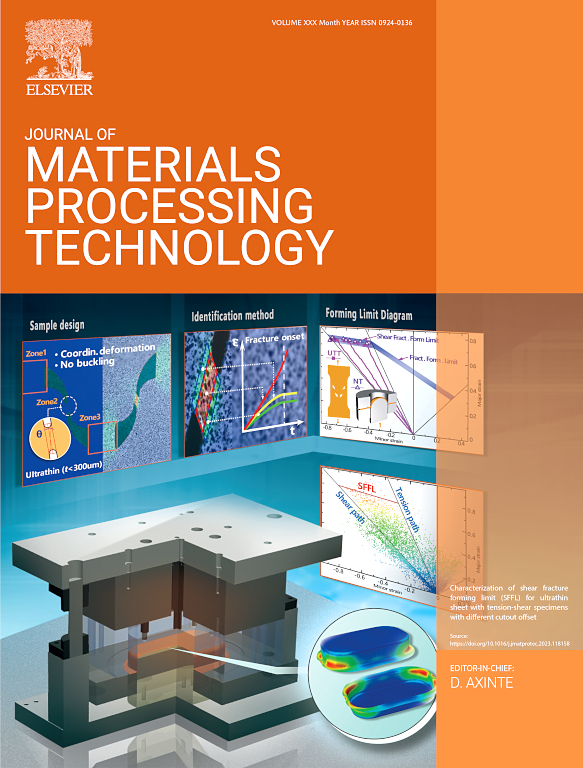Mechanistic investigation of thickness-controlled microstructure and magnetic performance in Sb-microalloyed ultra-thin Fe-6.5 %Si ribbons fabricated by planar flow casting
IF 7.5
2区 材料科学
Q1 ENGINEERING, INDUSTRIAL
Journal of Materials Processing Technology
Pub Date : 2025-07-17
DOI:10.1016/j.jmatprotec.2025.118990
引用次数: 0
Abstract
Planar flow casting (PFC) is recognized as a promising near-net-shape technology for fabricating Fe-6.5 %Si alloy ribbons. However, its application is constrained by poor melt wettability, insufficient cooling efficiency, and unstable thickness control. To address these challenges, this study introduces a synergistic strategy combining Sb-induced surface energy reduction with enhanced system cooling capacity, enabling the stable fabrication of ultra-thin Fe-6.5 %Si-0.1 %Sb ribbons with controlled thicknesses. Subsequent low-strain rolling and annealing were further employed to optimize magnetic performance. A systematic investigation was conducted to clarify the mechanisms linking processing conditions, microstructural evolution, and magnetic performance. Results reveal that ribbon thickness regulates the cooling rate, thereby governing grain growth, texture formation and B2/D03 ordered phases precipitation. Thicker ribbon exhibits a more favorable texture, resulting in higher magnetic induction. Based on loss separation theory and microstructural analysis, total iron loss in annealed ribbons is determined by the frequency-dependent interplay between hysteresis and eddy current losses, which are primarily governed by grain size and ribbon thickness, respectively. At medium frequencies where hysteresis loss dominates, total loss decreases monotonically with grain size. At high frequencies, thicker ribbons exhibit increased eddy current loss but reduced hysteresis loss due to larger grain size. Such a competitive mechanism leads to a non-monotonic variation in total iron loss. This work presents a research paradigm for planer flow casting of ultra-thin Fe-6.5 %Si ribbons and provides theoretical insights and useful references for the manufacture of other high-performance metallic foils.
平面流动铸造sb微合金Fe-6.5 %Si超薄带厚度控制组织和磁性能的机理研究
平面流动铸造(PFC)被认为是一种很有前途的制造Fe-6.5 %Si合金带的近净形技术。但其应用受到熔体润湿性差、冷却效率不足、厚度控制不稳定等问题的制约。为了应对这些挑战,本研究引入了一种协同策略,将Sb诱导的表面能降低与增强的系统冷却能力相结合,从而能够稳定地制造出厚度可控的超薄Fe-6.5 %Si-0.1 %Sb带。随后的低应变轧制和退火进一步优化了磁性能。系统地研究了加工条件、微观组织演变和磁性能之间的联系机制。结果表明,带状厚度调节冷却速率,从而控制晶粒生长、织构形成和B2/D03有序相的析出。更厚的带具有更有利的纹理,导致更高的磁感应强度。基于损耗分离理论和显微组织分析,退火带中的总铁损耗是由磁滞和涡流损耗之间的频率相关相互作用决定的,而磁滞和涡流损耗分别主要由晶粒尺寸和带的厚度决定。在迟滞损耗占主导地位的中频,总损耗随晶粒尺寸单调减小。在高频率下,更厚的带表现出增加的涡流损耗,但由于更大的晶粒尺寸,减少了磁滞损耗。这种竞争机制导致总铁损失的非单调变化。本研究为超薄Fe-6.5 %Si带的刨床流铸提供了一种研究范式,为其他高性能金属箔的制造提供了理论见解和有益的参考。
本文章由计算机程序翻译,如有差异,请以英文原文为准。
求助全文
约1分钟内获得全文
求助全文
来源期刊

Journal of Materials Processing Technology
工程技术-材料科学:综合
CiteScore
12.60
自引率
4.80%
发文量
403
审稿时长
29 days
期刊介绍:
The Journal of Materials Processing Technology covers the processing techniques used in manufacturing components from metals and other materials. The journal aims to publish full research papers of original, significant and rigorous work and so to contribute to increased production efficiency and improved component performance.
Areas of interest to the journal include:
• Casting, forming and machining
• Additive processing and joining technologies
• The evolution of material properties under the specific conditions met in manufacturing processes
• Surface engineering when it relates specifically to a manufacturing process
• Design and behavior of equipment and tools.
 求助内容:
求助内容: 应助结果提醒方式:
应助结果提醒方式:


